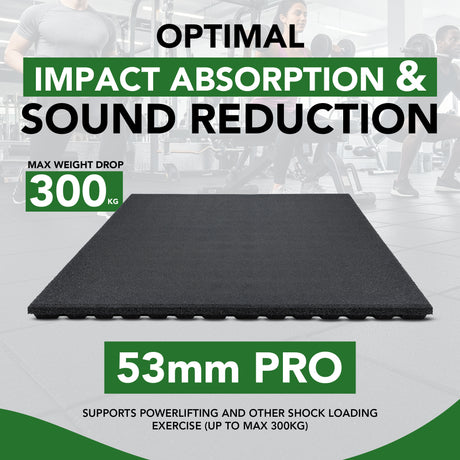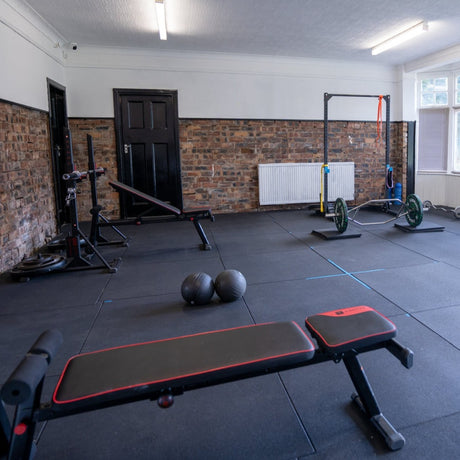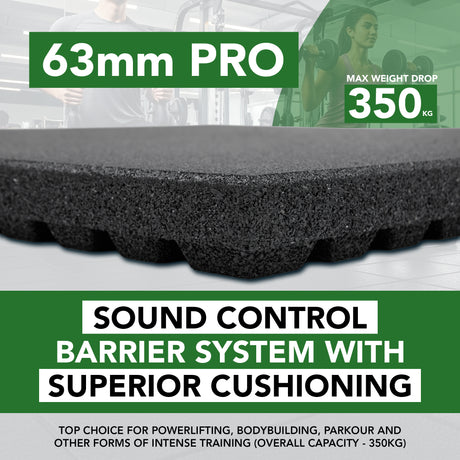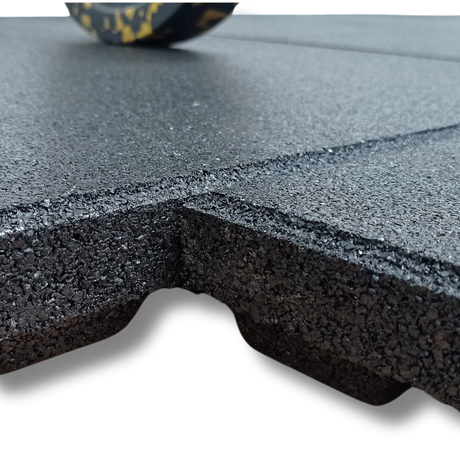63mm Sprung PRO Gym Anti-Shock Flooring Tile - Max Weight Drop 350KG
£121.00£151.25Unit price /Unavailable
Powerlifting is one of the most demanding strength sports, focused on maximizing performance in three fundamental lifts: the squat, bench press, and deadlift. Each of these movements requires tremendous strength and precision, and the environment in which they’re performed is crucial to ensuring both the athlete’s safety and the protection of the gym’s equipment.
One of the most critical components of any powerlifting setup is the flooring. Powerlifting flooring must be durable, stable, and designed to withstand the immense forces generated by heavy weights.
At Sprung Flooring, we specialise in providing high-quality flooring solutions tailored to the specific needs of powerlifting athletes and facilities. Whether you are outfitting a dedicated powerlifting gym, a commercial training centre, or a home setup, choosing the right flooring can make a significant difference in performance, safety, and longevity.
The Importance of Proper Flooring in Powerlifting
Powerlifting places unique demands on gym flooring. The extreme weights involved, combined with the explosive force generated during lifts, require a surface that can handle heavy impact while providing stability and support. Flooring for powerlifting needs to:
-
Absorb Impact and Shock: Powerlifting involves the repeated loading and unloading of heavy weights. When weights are dropped or set down, the flooring must absorb the shock to protect both the equipment and the floor itself. Without proper flooring, heavy weights can damage the surface, cause noise disturbances, and create unsafe conditions.
-
Provide Stability for Lifts: Powerlifting requires precise technique and control, and athletes rely on stable footing to perform each lift correctly. The flooring must provide enough grip to prevent slipping, while remaining firm enough to support maximum force during squats, deadlifts, and bench presses.
-
Prevent Damage to Equipment: High-quality powerlifting equipment, such as barbells, plates, and racks, represents a significant investment for gym owners. Flooring designed specifically for powerlifting can help protect this equipment from damage caused by repeated drops or heavy usage.
-
Minimize Noise and Vibration: In a busy gym or training facility, the sound and vibration caused by dropping weights can be disruptive. Proper powerlifting flooring helps reduce noise levels and absorb vibrations, creating a more pleasant environment for athletes and gym-goers alike.
-
Ensure Durability and Longevity: Powerlifting flooring must be built to last. The constant pressure from heavy weights and high-impact movements can wear down subpar flooring over time. High-quality, durable materials are essential to withstand the rigours of daily powerlifting training.
Key Considerations for Powerlifting Flooring
When selecting flooring for a powerlifting space, it’s important to consider several factors that impact the performance, safety, and durability of the surface. At Sprung Flooring, we guide our clients through these key considerations to ensure they choose the best solution for their needs.
1. Impact Absorption and Shock Resistance
One of the most critical aspects of powerlifting flooring is its ability to absorb the impact of dropped weights. During deadlifts and squats, heavy barbells are often set down or dropped from a height, generating significant force. Flooring that is not designed to handle this impact can crack, dent, or wear down quickly. Rubber flooring, especially in thicker formats, is an ideal solution for absorbing shock and preventing damage to both the floor and the equipment.
2. Stability and Traction
Powerlifting requires athletes to have stable footing during lifts. Slippery or uneven surfaces can lead to poor technique, decreased performance, and even injury. Flooring designed for powerlifting should offer enough traction to prevent slipping, while remaining firm underfoot to support the maximum force exerted during lifts like squats and deadlifts. Harder rubber surfaces are particularly effective for providing the stability needed for powerlifting.
3. Floor Protection
Gym owners often invest heavily in their facilities, and protecting the gym’s floor is essential. Dropping weights directly onto concrete or hardwood floors can cause cracks, chips, and other damage. A durable, impact-resistant flooring solution like rubber or high-density foam protects the underlying floor, extending the life of the training space and minimizing repair costs.
4. Sound and Vibration Reduction
The noise generated by powerlifting can be disruptive, especially in multi-use training facilities. Dropped weights can cause loud bangs and send vibrations through the floor, which can disturb other gym users or neighbouring businesses. Flooring designed to dampen sound and absorb vibrations helps create a more peaceful training environment. Thick rubber flooring and shock-absorbing platforms are effective at minimising noise and vibration in powerlifting areas.
5. Durability and Maintenance
Powerlifting flooring must be able to withstand daily use under extreme conditions. The surface will be exposed to heavy weights, high-impact movements, and constant foot traffic. Choosing a durable flooring material is essential to ensure it lasts over time. Additionally, powerlifting areas can get dirty quickly, so the flooring should be easy to clean and maintain. Rubber and vinyl flooring are both excellent options in this regard, as they are resistant to moisture, stains and wear.
Best Flooring Types for Powerlifting
At Sprung Flooring, we offer a range of flooring options designed specifically for powerlifting environments. Each type of flooring has unique properties that make it well-suited to the demands of the sport.
1. Rubber Flooring
Rubber flooring is the most popular choice for powerlifting areas due to its durability, shock absorption and slip-resistant properties. It provides a stable, firm surface for lifting, while also protecting the floor and equipment from damage.
2. Interlocking Rubber Tiles
Interlocking rubber tiles offer the same benefits as traditional rubber flooring, but with added flexibility in installation and customisation. These tiles can be easily installed and replaced as needed, making them a versatile option for powerlifting areas.
3. Olympic Weightlifting Platforms
Olympic weightlifting platforms are designed specifically for areas where heavy weights are lifted and dropped repeatedly. These platforms combine a durable wood or rubber centre with shock-absorbing edges to provide a stable lifting surface while protecting the floor and equipment.
4. High-Density Foam Mats
High-density foam mats provide a softer alternative to rubber flooring, offering excellent impact absorption and cushioning. While foam mats are not typically used in main powerlifting areas, they can be beneficial in zones where athletes perform accessory lifts, stretches, or recovery exercises.
You may be interested in: Outdoor Functional Training Surfaces






